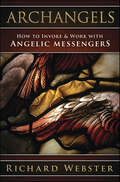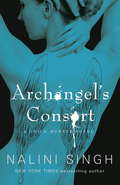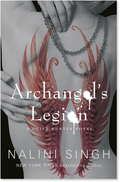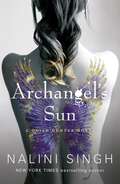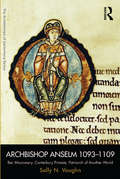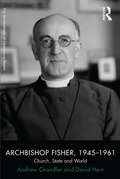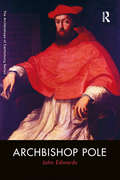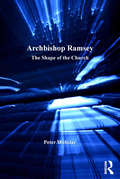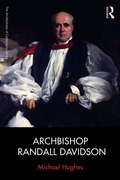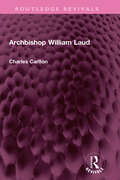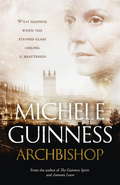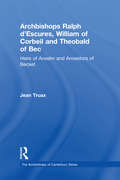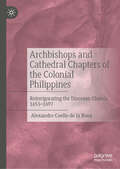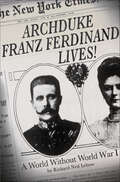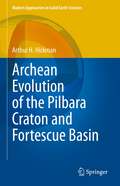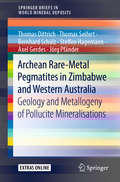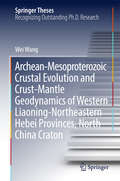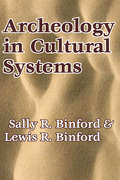- Table View
- List View
Archangels: How to Invoke & Work with Angelic Messengers
by Richard WebsterTransform Your Life with the Power and Grace of Divine MessengersAs beings of pure light who possess great influence, archangels can help you achieve your goals and develop a closer relationship with the Divine. Drawing from multiple spiritual paths, bestselling author Richard Webster introduces you to the four most-recognized archangels—Michael, Raphael, Gabriel, and Uriel—as well as numerous lesser-known angels who are rarely featured in other books. You will also learn simple meditations and rituals to help you communicate and work with them for protection, guidance, and wisdom.This concise and conversational guide describes the hierarchy of angels and the unique responsibilities for each one. With detailed information on correspondences for each archangel, including crystal, essential oil, element, zodiac sign, and chakra, you'll discover which ones to connect with and how they can support you. Featuring affirmations, invocations, dream work, and more, this book makes it easy to seek angelic assistance and enjoy a life filled with peace, harmony, and divine love.
Archangel’s Consort: The Guild Hunter Series
by Nalini SinghNEW YORK TIMES-bestselling author Nalini Singh returns to her world of angelic rulers, vampiric servants, and the woman thrust into their darkly seductive world …Nalini Singh steps back into the shadows of her heartbreakingly original world where angels rule, vampires serve, and the innocent can pay the greatest price of all … Vampire hunter Elena Deveraux and her lover, the lethally beautiful archangel Raphael, have returned home to New York only to face an uncompromising new evil … A vampire has attacked a girls¿ school– the assault one of sheer, vicious madness– and it is only the first act. Rampant bloodlust takes vampire after vampire, threatening to make the streets run with blood. Then Raphael himself begins to show signs of an uncontrolled rage, as inexplicable storms darken the city skyline and the earth itself shudders. The omens are suddenly terrifyingly clear. An ancient and malevolent immortal is rising. The violent winds whisper her name: Caliane. She has returned to reclaim her son, Raphael. Only one thing stands in her way: Elena, the consort who must be destroyed …
Archangel’s Legion
by Nalini SinghNalini Singh, the NEW YORK TIMES bestselling ‘alpha author of paranormal romance’ (BOOKLIST), returns to an immortal world of violent passion and lethal power . . . on the brink of a deadly archangelic war.
Archangel’s Sun (A\guild Hunter Novel Ser. #13)
by Nalini SinghA horrifying secret rises in the aftermath of an archangelic war in New York Times bestselling author Nalini Singh’s deadly and beautiful Guild Hunter world…
Archbishop Anselm 1093–1109: Bec Missionary, Canterbury Primate, Patriarch of Another World (The Archbishops of Canterbury Series)
by Sally N. VaughnSt Anselm's archiepiscopal career, 1093-1109, spanned the reigns of two kings: William Rufus and the early years of Henry I. As the second archbishop of Canterbury after the Norman Conquest, Anselm strove to extend the reforms of his teacher and mentor at Bec, and his predecessor at Canterbury, Archbishop Lanfranc. Exploring Anselm's thirty years as Prior and Abbot of the large, rich, Norman monastery of Bec, and teacher in its school, this book notes the wealth of experiences which prepared Anselm for his archiepiscopal career--in particular Bec's missionary attitude toward England. Sally Vaughn examines Anselm's intellectual strengths as a teacher, philosopher and theologian: exploring his highly regarded theological texts, including his popular Prayers and Meditations, and how his statesmanship was influenced as he dealt with conflict with the antagonistic King William Rufus. Vaughn argues that Rufus's death influenced Anselm's rivalry with King Henry I and fostered a more subdued and civil conflict between Anselm and Henry which ended with cooperation between king and archbishop at the end of Anselm's life. King and archbishop became’yoked together as two oxen pulling the plow of the church through the land of England’. Anselm’s final years at the pinnacle of power reveal a superb administrator over Canterbury and Primate over the churches of all Britain, in which position his followers described him as 'Pope of another world'. The final section includes a selection of original source material including archiepiscopal letters drawn primarily from Lambeth Palace Library.
Archbishop Fisher, 1945–1961: Church, State and World (The Archbishops of Canterbury Series)
by David Hein Andrew ChandlerArchbishop Fisher’s archiepiscopate reflected the central issues of his time and place. It was Fisher who oversaw an immense programme of reforms which effectively recast the institutions of the Church of England for generations to come. It was Fisher who proved to be the essential architect, politician and diplomat behind the creation of a worldwide Anglican Communion. His determination to promote the development of relations with other churches produced a vital contribution to the cause of ecumenism, which culminated in his momentous meeting with Pope John XXIII. Archbishop Fisher was a vigorous participant in the questions which defined national and international life. This book explores Fisher’s influence on major contemporary issues and events, including divorce-law reform and capital punishment at home and the end of Empire and the most dangerous years of the Cold War abroad. This new biography establishes the continuing significance not only of the office of Archbishop in the Church but also of the Church at large in the tumultuous world of the later twentieth century. A final section of original source material includes letters, sermons and other writings bringing vividly to life the range and character of Fisher's public and private role.
Archbishop Grindal, 1519-1583: The Struggle for a Reformed Church
by Patrick CollinsonThis title is part of UC Press's Voices Revived program, which commemorates University of California Press’s mission to seek out and cultivate the brightest minds and give them voice, reach, and impact. Drawing on a backlist dating to 1893, Voices Revived makes high-quality, peer-reviewed scholarship accessible once again using print-on-demand technology. This title was originally published in 1977.
Archbishop Howley, 1828-1848 (The Archbishops of Canterbury Series)
by James GarrardWilliam Howley, Archbishop of Canterbury 1828-1848, led the Church of England during the beginning and expansion of the Oxford Movement, at a time when the precursor to the Church Commissioners was established, and during the momentous debates and decisions in Parliament which saw the final retreat from the myth of an all Anglican legislature. Howley’s chairmanship of the commissions of the 1830s and 1840s which began the gargantuan task of reforming the Church’s practices and re-arranging its finances, made him an object of fury and scorn to some of those who benefited from things as they were, most especially in the cathedrals. Exploring the central events and debates within the Church of England in the first half of the nineteenth century, this book draws on primary and secondary evidence about Howley’s career and influence. A section of original sources, including his Charges and other public documents, correspondence and speeches in the House of Lords, places Howley’s achievements in proper context and illustrates his prevailing concerns in education, the establishment and political reform, relationships with the Tractarians, and in the early stages of Church reform. Dealing thematically with many of the issues faced by Howley, and exploring his own High Church theological views in historical context, James Garrard offers a fruitful re-appraisal of the intellectual, spiritual and ’party’ context in which Howley moved.
Archbishop Pole (The Archbishops of Canterbury Series)
by John EdwardsThis fresh exploration of the life, work and writing of Archbishop Pole, focuses particularly on Pole’s final years (1556-58) as Archbishop of Canterbury. Fully integrating Pole’s English and Continental European experiences, John Edwards places these in their historical context and signposts lessons for contemporary issues and concerns. Stressing the events and character of Pole's 'English' life, up to his exile in the 1530s, as well as in his final years in England (1554-58), this book explores his close relationship, both genealogical and emotional, with Henry VIII and Mary I. Portraying Pole as a crucial figure in the Catholic-Protestant division, which still affects Britain today, this book details the first, and so far last, attempt to restore Roman Catholicism as the 'national religion' of England and Wales by telling the life-story of the hinge figure in forging English religious and political identity for several centuries. The final section of this book draws together important and illuminating source material written by Pole during his years as Archbishop of Canterbury.
Archbishop Ramsey: The Shape of the Church (The Archbishops of Canterbury Series)
by Peter WebsterArchbishop Michael Ramsey’s archiepiscopate from 1961 to 1974 saw profound renegotiations of the relationship of the Church of England with its own flock, with the nation more widely, with the Anglican church worldwide, and with the other Christian churches. Drawing from unique source material in the Lambeth Palace Library archives and reproducing many original writings of Ramsey for the first time, this book explores key questions which surround Ramsey’s tenure. How did Ramsey react to the rapid hollowing-out of the regular constituency of the church whilst at the same time seeing sweeping changes in the manner in which the church tried to minister to those members? What was his role in the widening of the church's global vision, and the growing porousness of its borders with other denominations? And how did the nature of the role of archbishop as figurehead change in this period?
Archbishop Randall Davidson (The Archbishops of Canterbury Series)
by Michael HughesRandall Davidson was Archbishop of Canterbury for quarter of a century. Davidson was a product of the Victorian ecclesiastical and social establishment, whose advance through the Church was dependent on the patronage of Queen Victoria, but he became Archbishop at a time of huge social and political change. He guided the Church of England through the turbulence of the Edwardian period, when it faced considerable challenges to its status as the established Church, as well as helping shape its response to the horrors of the First World War. Davidson inherited a Church of England that was sharply divided on a range of issues, and he devoted his career as Archbishop to securing its unity, whilst ensuring that its voice continued to be heard both nationally and internationally. A modest and pragmatic man, he was widely respected both within the Church of England and beyond, helping to find solutions to a range of political and ecclesiastical problems. This book explores Davidson’s role within the Church and in the life of Britain more broadly during his time at Canterbury. It includes a large selection of documents that help to reveal the Archbishop’s character and cast light on the way in which he carried out his varied and demanding duties.
Archbishop William Laud (Routledge Revivals)
by Charles CarltonFirst published in 1987, Archbishop William Laud shows how Laud dragged the English Church, and with it English society, towards a new and radical version of Anglicanism. Carlton presents Laud in the context of his times, showing how closely his personal life and character were woven into his political and religious career. By using Laud’s personal papers, his letters and diary, Carlton draws a psychological profile of this most insecure man. He analyses Laud’s dreams, revealing that both awake and asleep the archbishop was haunted by some guilty secret, obsessed with details, bedevilled by enemies and conspiracies, while being both ashamed and proud of his own humble origins. The tensions between Laud’s private and public worlds made him seem cruel, thus turning him into the perfect scapegoat for the failure of the king’s policies. This book will be of interest to students of history, literature and psychology.
Archbishop: A Novel
by Michele GuinnessFive years from now, the Church of England is on its knees. Yet one woman is making a difference, and when she is appointed Archbishop of Canterbury, anything could happen.Vicky Burnham-Woods is a master of diplomacy, and deeply committed to bringing the church back into the heart of community and cultural life - but not everyone wants a woman at the top, and behind the scenes dark forces are moving.Can the first ever female Archbishop of Canterbury last long enough to achieve her mission?
Archbishop: A novel
by Michele GuinnessFive years from now, the Church of England is on its knees. Yet one woman is making a difference, and when she is appointed Archbishop of Canterbury, anything could happen.Vicky Burnham-Woods is a master of diplomacy, and deeply committed to bringing the church back into the heart of community and cultural life - but not everyone wants a woman at the top, and behind the scenes dark forces are moving.Can the first ever female Archbishop of Canterbury last long enough to achieve her mission?
Archbishops Ralph d'Escures, William of Corbeil and Theobald of Bec: Heirs of Anselm and Ancestors of Becket (The Archbishops of Canterbury Series)
by Jean TruaxThe first two archbishops of Canterbury after the Norman Conquest, Lanfranc and Anselm, were towering figures in the medieval church and the sixth archbishop, the martyred Thomas Becket, is perhaps the most famous figure ever to hold the office. In between these giants of the ecclesiastical world came three less noteworthy men: Ralph d'Escures, William of Corbeil, and Theobald of Bec. Jean Truax's volume in the Ashgate Archbishops of Canterbury Series uniquely examines the pontificates of these three minor archbishops. Presenting their biographies, careers, thought and works as a unified period, Truax highlights crucial developments in the English church during the period of the pontificates of these three archbishops, from the death of Anselm to Becket. The resurgent power of the papacy, a changed relationship between church and state and the expansion of archiepiscopal scope and power ensured that in 1162 Becket faced a very different world from the one that Anselm had left in 1109. Selected correspondence, newly translated chronicle accounts and the text and a discussion of the Canterbury forgeries complete the volume.
Archbishops and Cathedral Chapters of the Colonial Philippines: Reinvigorating the Diocesan Church, 1653-1697
by Alexandre Coello de la RosaThis volume analyzes the religious history of the early modern Philippines. It examines the unstable authority of its archbishops and the preeminence of the Manila cathedral chapters in the second half of the seventeenth century. In particular, it considers these phenomena during the various convoluted periods of vacant sees, paying special attention to the dynamics of promotions within these collegiate bodies.
Archduke Franz Ferdinand Lives!: A World Without World War I
by Richard Ned LebowArchduke Franz Ferdinand Lives! presents an intellectually invigorating set of hypotheticals about the twentieth century--had we been smart enough to avoid World War I.The "Great War" claimed nearly 40 million lives and set the stage for World War II, the Holocaust, and the Cold War. More than one hundred years later, historians are beginning to recognize how unnecessary it was. In Archduke Franz Ferdinand Lives!, acclaimed political psychologist Richard Ned Lebow examines the chain of events that led to war and what could reasonably have been done differently to avoid it. In this highly original and intellectually challenging book, he constructs plausible worlds, some better, some worse, that might have developed. He illustrates them with "what-if" biographies of politicians, scientists, religious leaders, artists, painters, and writers, sports figures, and celebrities, including scenarios where: there is no Israel; neither John Kennedy nor Barack Obama become president; Curt Flood, not Jackie Robinson, integrates baseball; Satchmo and many Black jazz musicians leave for Europe, where jazz blends with klezmer; nuclear research is internationalized and all major countries sign a treaty outlawing the development of atomic weapons; Britain and Germany are entrapped in a Cold War that threatens to go nuclear; and much more.
Archduke of Sarajevo
by Gordon Brook-ShepherdA biography of the ill-fated Franz-Ferdinand whose assassination in 1914 set in motion the train of events that led to World War One
Archean Evolution of the Pilbara Craton and Fortescue Basin (Modern Approaches in Solid Earth Sciences #24)
by Arthur H. HickmanOne of today’s major geoscientific controversies centres on the origin of the Archean granite‒greenstone terranes. Is the geology of these scattered remnants of our planet’s early crust consistent with the theory that modern-style plate-tectonic processes operated from the early Archean, or does it indicate that tectonic and magmatic processes were different in the Archean? Earth has clearly evolved since its initial formation, so at what stage did its processes of crustal growth first resemble those of today? The logical place to seek answers to these intriguing and important questions is within the best-preserved early Archean crust. The Pilbara region of northwest Australia is internationally famous for its abundant and exceptionally well-preserved fossil evidence of early life. However, until recently the area has received much less recognition for the key evidence it provides on early Archean crustal evolution. This book presents and interprets this evidence through a new stage-by-stage account of the development of the Pilbara’s geological record between 3.53 and 2.63 Ga. The Archean Pilbara crust represents one fragment of Earth’s oldest known supercontinent Vaalbara, which also included the Kaapvaal Craton of southern Africa. Recognition of Vaalbara expands the background database for both these areas, allowing us to more fully understand each of them.
Archean Rare-Metal Pegmatites in Zimbabwe and Western Australia: Geology and Metallogeny of Pollucite Mineralisations (SpringerBriefs in World Mineral Deposits)
by Thomas Seifert Thomas Dittrich Bernhard Schulz Steffen Hagemann Axel Gerdes Jörg PfänderLithium-cesium-tantalum (LCT) pegmatites are important resources for rare metals. For Cs, only the LCT pegmatites with the zeolite group mineral pollucite at Bikita (Zimbabwe Craton) and Tanco (Superior Province Craton) are of commercial importance. Common characteristics of world-class LCT pegmatite deposits include their Meso- to Neoarchean age and geological setting within greenstone belt lithologies on Archean Cratons.This study presents the first coherent and comparative scientific investigation of five major LCT pegmatite systems from the Yilgarn, Pilbara and Zimbabwe Craton. For the evaluation of their Cs potential and of the genetic concepts of pollucite formation, the pegmatites from Wodgina, Londonderry, Mount Deans and Cattlin Creek were compared to the Bikita pollucite mineralization. The integration of the new data (e.g., geochronological and radiogenic isotope data) into the complex geological framework: 1) enhances our knowledge of the formation of LCT pegmatite systems, and 2) will contribute to the further exploration of additional world-class LCT pegmatite deposits, which 3) may host massive pollucite mineralisations.
Archean-Mesoproterozoic Crustal Evolution and Crust-Mantle Geodynamics of Western Liaoning-Northeastern Hebei Provinces, North China Craton (Springer Theses)
by Wei WangThis thesis presents geological, petrological, geochemical, and zircon U-Pb-Lu-Hf isotopic field data for representative Precambrian lithologies in the Western Liaoning-Northeastern Hebei Provinces along the northern margin of the North China Craton (NCC). It describes late Neoarchean (2. 64-2. 48 Ga) supracrustal metavolcanic rocks and granitoid gneisses; late Paleoproterozoic (1. 72-1. 68 Ga) Jianping alkaline plutons and Pinggu alkaline volcanic rocks; and newly discovered ~1. 23 Ga mafic dykes. The nature of magma sources and genesis of each magmatic episode are investigated, and the Precambrian (~2. 6-1. 2 Ga) lithospheric mantle evolution and crust-mantle interaction processes are established for the first time -aspects that provide important constraints in our understanding of the Precambrian crustal evolution and geodynamic processes in the region studied.
Archenemies (Renegades #2)
by Marissa Meyer<p>Nova’s double life is about to get a lot more complicated: <p>As Insomnia, she is a full-fledged member of the Renegades, a syndicate of powerful and beloved superheroes. She works with Adrian’s patrol unit to protect the weak and maintain order in Gatlon City. <p>As Nightmare, she is an Anarchist - a group of of villains who are determined to destroy the Renegades. Nova wants vengeance against the so-called heroes who once failed her when she needed them most. <p>But as Nova, her feelings for Adrian are deepening, despite the fact that he is the son of her sworn enemies and, unbeknownst to Nova, he has some dangerous secrets of his own. <p>In this second installment of the Renegades trilogy, Nova, Adrian, and the rest of their crew – Ruby, Oscar, and Danna -- are faced with escalating crime in Gatlon City, while covert weapons and conflicting missions have Nova and Adrian questioning not only their beliefs about justice, but also the feelings they have for each other. <p>The line between good and evil has been blurred, but what's clear to them both is that too much power could mean the end of their city – and the world – as they know it.</p>
Archenemy (Counterattack)
by Patrick HuellerAs a defender for the Fraser High girls soccer team, Addie used to be ready for anything. There was no play she couldn't shut down. But now the biggest threat on the field is one of her teammates . . . who is also Addie's former best friend. When Eva Riley moved to town, she and Addie became super close. But when Eva wanted to be more than friends, Addie put soccer first instead. Suddenly Eva's sending Addie mean notes. Then she's screwing up Addie's plays. After a while, Addie's not sure she even wants her friend back. She has to worry about other things—like keeping her spot on the team after Eva's latest act of sabotage.
Archeologies of Confession: Writing the German Reformation, 1517-2017 (Spektrum: Publications of the German Studies Association #16)
by David M. Luebke Jesse Spohnholz Carina L. Johnson Marjorie E. PlummerModern religious identities are rooted in collective memories that are constantly made and remade across generations. How do these mutations of memory distort our picture of historical change and the ways that historical actors perceive it? Can one give voice to those whom history has forgotten? The essays collected here examine the formation of religious identities during the Reformation in Germany through case studies of remembering and forgetting—instances in which patterns and practices of religious plurality were excised from historical memory. By tracing their ramifications through the centuries, Archeologies of Confession carefully reconstructs the often surprising histories of plurality that have otherwise been lost or obscured.
Archeology in Cultural Systems
by Lewis R. BinfordArcheology shares with other anthropological sciences the goal of explaining differences and similarities among cultural systems. Sally R. Binford and Lewis R. Binford, therefore are concerned with theory and arguments which treat problems of the interrelationship of cultural variables with explanatory value. Archeology in Cultural Systems is devoted to four different aspects of archeology.This book progresses from theoretical-methodological discussions to specific consideration of archeological materials. It focuses on the analysis of archeological remains from a single site. Its concern is primarily with recognizing, measuring and explaining variability in the form and distribution of a site's cultural remains. The authors argue that internal variability derives from the composition and distribution of societal segments represented at the site. The work then shifts to study of archeological components (or their attributes) and seeks explanations for observed differences and similarities. A final section of the volume comments and discusses materials in the volume.Archeology in Cultural Systems is not a monolithic presentation of any particular school of archeological thought. There are common interests and many points of agreement among the authors, but there is also diversity of opinion on several points. These points are the focus of research here.
